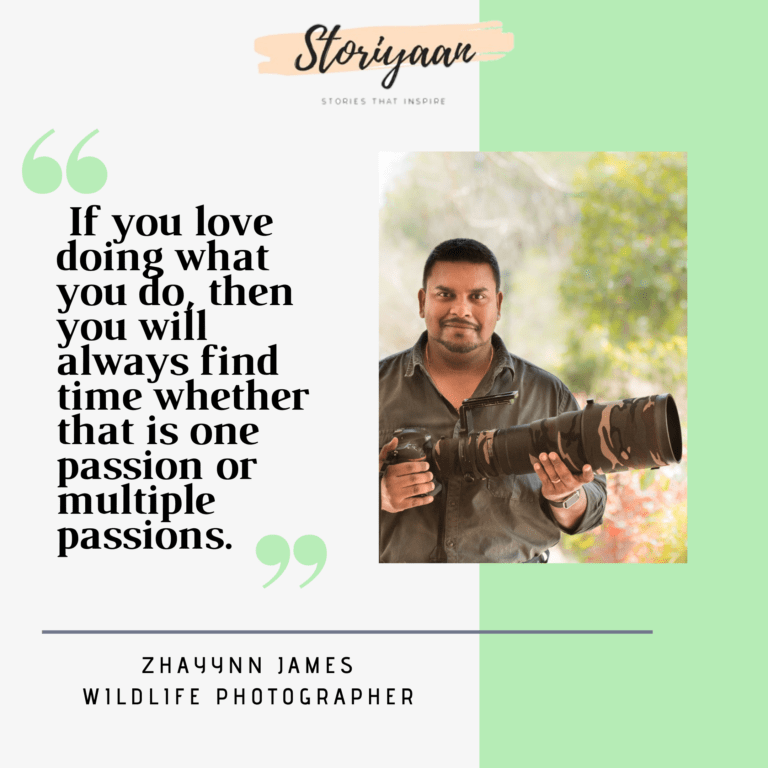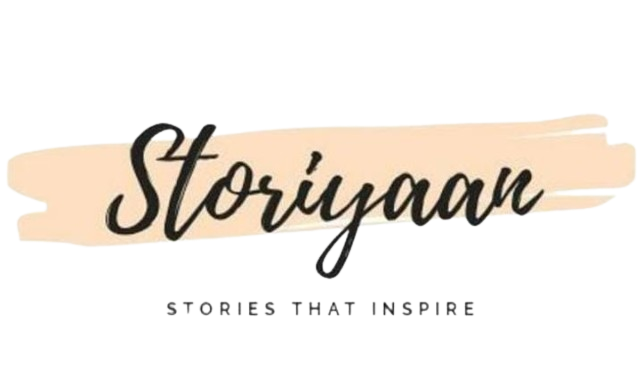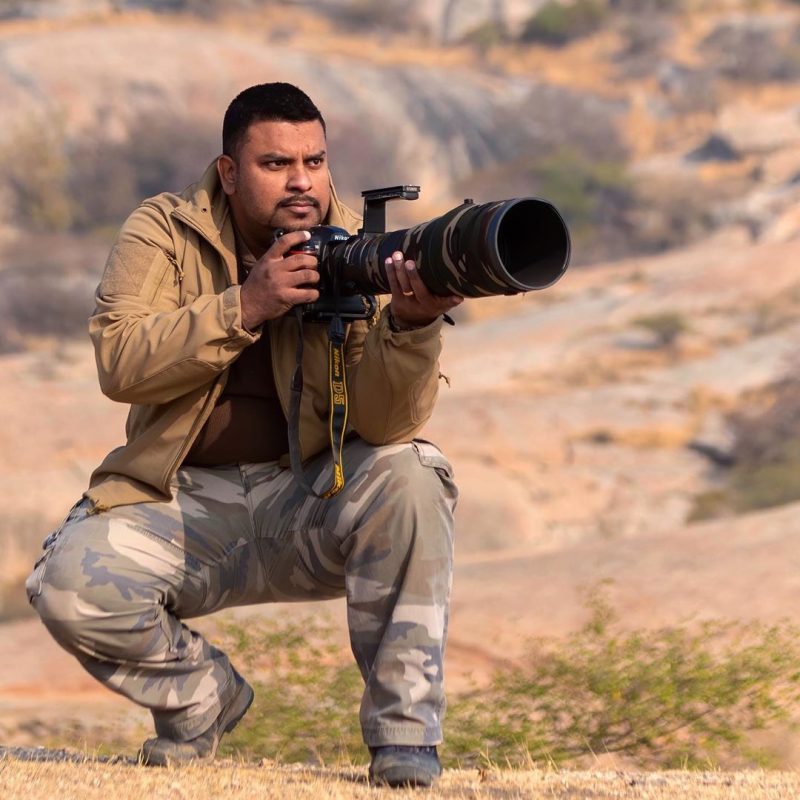Zhayynn James, is wildlife photographer and a landscape architect.Since wildlife photography is an extremely difficult kind of photography let us learn with Zhayynn what makes him a perfect wildlife photographer.
Team Storiyaan with an interview on Zhayynn James learnt about the true essence of Wildlife Photography. Read further to know more about @Zhayynnjamesphotography

Interview
Questions and answers
You have amazingly breath-taking wildlife photos on your Instagram. Since there are no rules of photography when it comes to wildlife photography, what kind of thrill do you experience being a wildlife photographer?
Thank you for your kind appreciation. Well, there are rules involved, even if one was to ignore the basic rules of photography. Most wildlife sanctuaries or national parks have rules of conduct, both to safeguard wildlife as well as people. It’s always important to remember that when we’re out in the wilderness, we’re in the animals’ home and we are merely guests and should leave an as little impact as possible on the animals and their home.
Every time I step into the wilderness, it is always with a sense of wonder, to be able to witness wildlife in their natural habitat, to observe and photograph behaviour that can only otherwise be seen on a natural history program on the TV.
In your life so far tell us the best thing that has happened to you
As clichéd as it sounds, my wife is undoubtedly the best thing that happened in my life. From a photography standpoint, she bought me my first DSLR and shared my love of wildlife. She surprises me with photography tours, with camera gear and is very supportive of my hobby, even though it involves travel and being away from home. Without her understanding and support, this would not be possible.
You are an ardent lover of nature. What is it about the nature that you love the most?
As a child of the ’70s, I grew up on the outskirts of Chennai, where local wildlife from birds, to fish, to snakes were part of my environment on virtually a daily basis. I grew up amid nature. Sadly, today those same places are concrete boxes devoid of even a blade of grass. This is why I treasure nature even more, as what exists today may be gone tomorrow because we don’t value nature for what it is. We believe it has value only in terms of what it could be replaced with.
Everyone experiences downfalls which are quite essential to growing. Narrate us anyone life-changing incident of your life
There are so many experiences that have happened that have shaped or moulded me in some way. In 2012 something happened, not to me personally, but it affected everyone in this country. The Nirbhaya incident. It shook me to the core, and it made me want to do something to help make people learn to defend themselves. As a martial artist, I realized that people could not protect themselves in a couple of weeks by learning a traditional martial art, which takes years to master. So we created S-KAPE (pronounced ESCAPE), to teach people how to defend themselves in real-world situations, in just a matter of weeks. This horrific incident changed my life because it allowed me the opportunity to create something to save others.
Zhayynn, you are professionally pursuing landscape architecture, which is a rare profession. Would you like to elaborate on the pros and cons of the same?
Being a landscape architect is lovely, as I get to work on projects where my role is to integrate nature into the built environment. That is such an important and much-needed role in this current era, where space is at a premium, and every possible opportunity must be taken to create landscaped areas to maintain an equilibrium.
How did photography happen to you? Which was the first click that made you realize that it's your calling?
For years I had always dabbled in photography, but without actually knowing anything technical. Everything was experimental. It was only after my wife bought me my first DSLR in 2013, and I did a basic photography workshop that year, that I began to explore photography more seriously. When one of my images was selected for a minor, but coveted award, the Daily Dozen on National Geographic’s Your Shot in 2015, that was the moment it dawned on me that this was something I was born to do.
You are awarded by the National Geographic, Vanity Fair and in many other prestigious international exhibitions. What drives you towards excelling every time you achieve an award?
Ever since I was a child, I used to read National Geographic magazines and was enthralled by the fantastic photographs they contained. When I had just begun my foray into wildlife photography, I wanted to make images that would captivate people the way those Nat Geo images captivated me. That drove me to learn how to visualize and create better pictures and not just take photos of what I see. Entering images in competitions where my work is judged alongside some of the best photographers in the world, and people whose work I admire is equally nerve-wracking as it is exciting. The reward of having National Geographic publish my photographs with the iconic yellow rectangle logo is something that I would never have believed possible and it, along with every award and publication, pushed me to believe in myself even more.
Photographs tend to capture a hundred emotions and tell a thousand stories. What elements do you consider while clicking pictures? Do you believe in breaking the symmetry or just winning photos raw and as they are?
That’s a great question. Firstly, for me, photography is the art of telling a story without words. No matter how specific guidelines help technically sound an image is, it has to connect with the viewer emotionally. My approach is to make pictures proactively, by pre-visualization. However, in wildlife photography, this isn’t always possible as a lot of it is reacting to unexpected behaviour or action, so capturing what nature offers as it happens is just as crucial. Here again, there is a distinction between anticipation and reaction. Knowing about the subject always provides the advantage of being able to predict or at least anticipate specific behaviour. The response is still slower than anticipation, and often the difference between nailing the shot and missing it is anticipation.
Choosing to go for symmetry or asymmetry depends purely on whether the subject lends itself to the asymmetrical or asymmetrical image. Forcing a perspective or composition will usually ruin the outcome.
My approach is not to stay with a fixed focal length of time and opportunity permits. I like to change compositions, orientation, focal lengths, shutter speeds, to switch from freezing the action to create motion blur panning, etc. The goal is to look for ways to make the most of every opportunity and not wait for the subject alone to provide the opportunity.
Wildlife photography is a challenging section of photography where you get to adventure and experiment, but at the same time, you are required to be quick, have a keen eye as well as good vision and focus. How have you managed to inherit it all in you? Was it hereditary, or did you develop it over a while?
There are necessarily two aspects to photography, the technical aspect and the aesthetic aspect. The professional is something that is developed by learning, similar to any other technical field. The artistic element is something that comes from within. Yes, specific guidelines help people to lean the aesthetics of composing an image, like the Rule of Thirds, however, in the field, it is an intuitive sense of visual balance, form, and aesthetics that helps make an image. For me, I would have to say that being a 2nd generation designer certainly helps with seeing details and composing aesthetically.
When did you start your journey on Instagram? How was it starting from a hundred followers to reaching a milestone?
When I opened my Instagram account in 2016, I had no idea what hashtags were essential to get people to view my feed. It took me a few months before a friend gently pointed out that without hashtags, my images would never be seen and appreciated, and my account would never grow. It was a prolonged process, but a fellow wildlife photographer advised me to never opt for paid or sponsored promotions and to be patient. That advice has served me well because now the milestones are passing faster and faster. Instagram is like wildlife photography. Patience is everything.
We guessed reading your profile that you are a multi-tasker. Do things ever get too exhausting as you are continuously travelling across the world?
If you love doing what you do, then you will always find the time, whether that is one passion or multiple passions. For me, that is being the Design Head at my family’s landscape architecture firm, a wildlife photographer, a martial artist and a self-defence Course Director at S-KAPE. It certainly is juggling many roles and responsibilities. Sometimes though, you have to prioritize what is more critical and devote time accordingly. I haven’t reached that point of feeling exhausted from travel or engaging in multiple avenues of interest. My work is my priority as that is what affords me the ability to indulge in an expensive hobby like wildlife photography.

